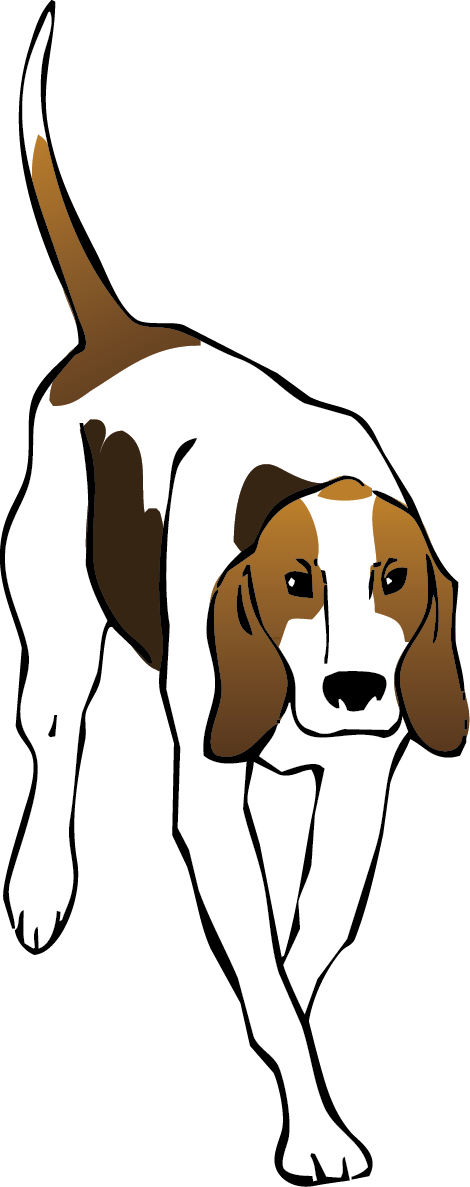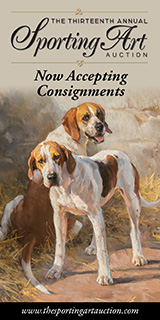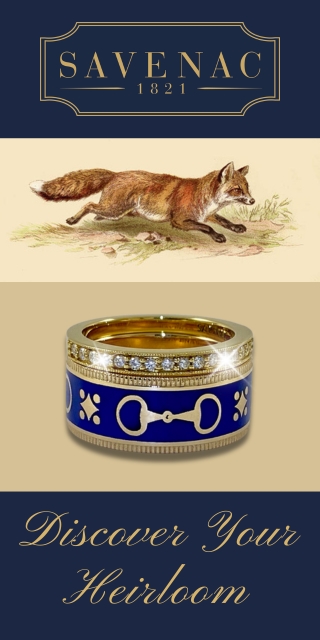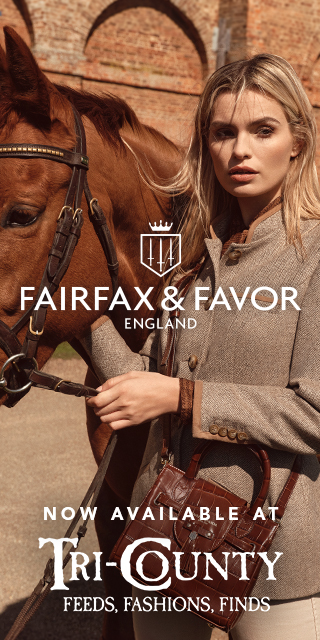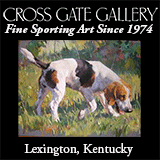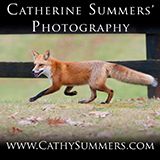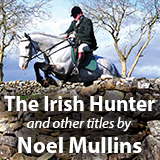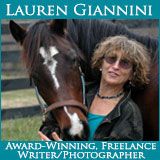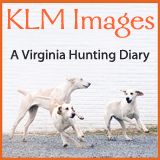Saxonburg Hunt
Sean Cully and Rose Tree-Blue Mountain Through Irish Eyes
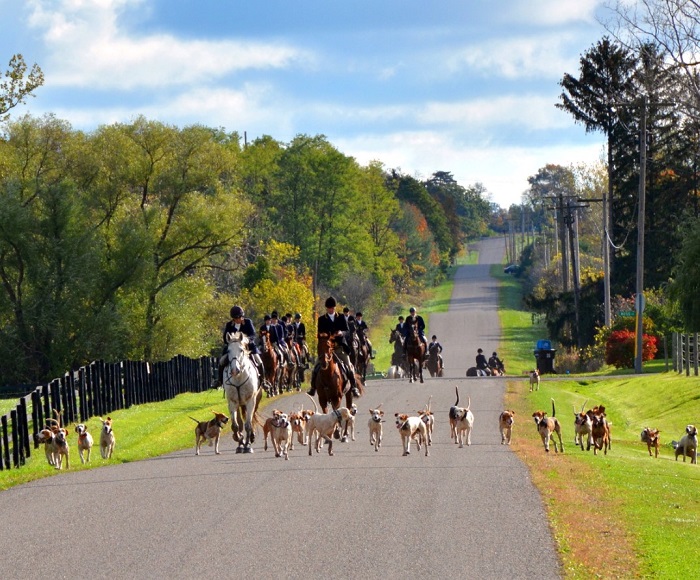 Sean Cully (center) hunts his hounds at a joint meet in Geneseo, New York, hosted by Marion Thorne, MFH and huntsman of the Genesee Valley Hounds (at left). / Noel Mullins photo
Sean Cully (center) hunts his hounds at a joint meet in Geneseo, New York, hosted by Marion Thorne, MFH and huntsman of the Genesee Valley Hounds (at left). / Noel Mullins photo
The first time I met Sean Cully he was Master and huntsman of the Blue Mountain Hounds (PA), and he was hunting an up-to-weight Irish Draught hunter. Blue Mountain, established by Cully in 1999 as a private foot pack, had been recently Registered by the MFHA.
On the occasion of our meeting, Cully was visiting Mr. Stewart’s Cheshire Foxhounds in Pennsylvania, celebrating their centennial year in 2013. Between then and now, this former Master and huntsman of a small foot pack has stabilized the foxhunting countries of two additional hunts in Pennsylvania under his Mastership and added winter fixtures near Aiken, South Carolina.
Hunt Mergers Bring Stability, Benefits
Sean Cully, MFH and huntsman (center), with hounds of the Rose Tree-Blue Mountain Hunt (PA). To the left is Brady Cully, whipper-in; to the right is Dr. Edward Franco, Joint-MFH and whipper-in.
When hunts merge, the resulting whole can often become greater than the sum of its parts. Take the case of a once-small hunt in Pennsylvania—the Blue Mountain Hunt. It was established by Sean Cully, MFH, in 1999 as a farmer’s foot pack. It became a mounted pack in 2009, was Registered with the MFHA in 2011, and became a Recognized pack in 2014.
Through unanticipated but judicious mergers, Cully’s little foot pack has stabilized a historic foxhunting country in Pennsylvania, rejuvenated the oldest subscription pack of foxhounds in the United States, and become a national influence and model for the sport.
Huntsmen On the Move: 2018
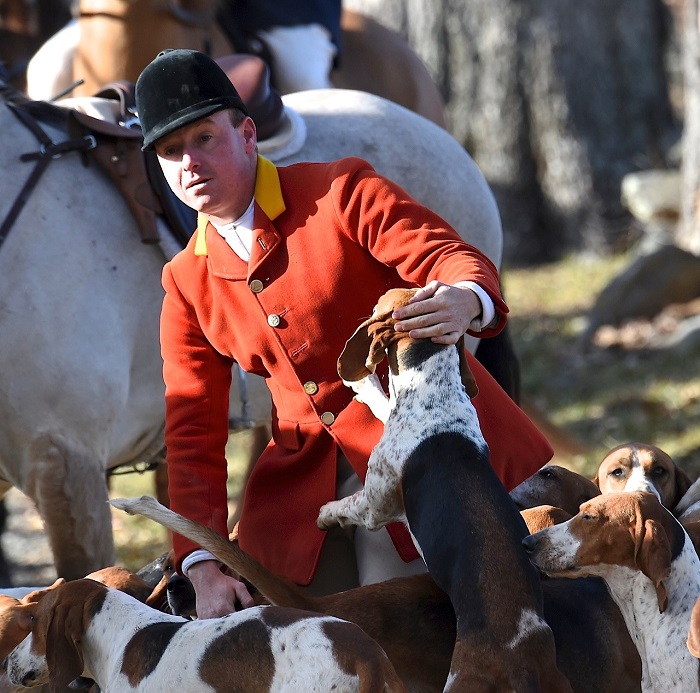 Neil Amatt will hunt hounds at Loudoun Fairfax.Having been a member of many fields in many hunting countries, the huntsman has always been my hero. From the time we mount up and for the few hours that follow, it is the huntsman who is most directly responsible for our day’s sport.
Neil Amatt will hunt hounds at Loudoun Fairfax.Having been a member of many fields in many hunting countries, the huntsman has always been my hero. From the time we mount up and for the few hours that follow, it is the huntsman who is most directly responsible for our day’s sport.
One might well argue that the hounds have something to do with it, and this I grant. But the pack is the product of the huntsman, and, since the level of sport depends on how hounds perform in the field as a pack, it all comes back to the huntsman.
Here’s our annual report on the recent moves of huntsmen Neil Amatt, Martyn Blackmore, Tony Gammell, and Sam Clifton.
Huntsmen On the Move: II
As the new season gets underway, Foxhunting Life updates its March 31 report on the recent moves of huntsmen across North America.
Huntsman Ashley Hubbard leads the Green Spring Valley hounds on summer exercise. / Tammie Monaco photo
Round I
Ashley Hubbard is the new huntsman for the Green Spring Valley Hounds (MD). Hubbard has served as kennel huntsman for the Fox River Valley Hunt (IL) for nearly ten years, assisting Tony Leahy, MFH, and carrying the horn when necessary.
“Tony didn’t want to lose him,” explained Duck Martin, MFH at Green Spring Valley, “but he thought this would be a good opportunity for Ashley.”
Since the end of World War II, Green Spring Valley has had just four huntsmen: Leslie Grimes, Andrew Barclay, John Tabachka, and Sam Clifton. Both Grimes and Barclay have been enshrined in the Huntsmen’s Room at the Museum of Hounds and Hunting.
Huntsmen on the Move: 2015
Huntsman Jordan Hicks moves from the Tryon Hounds to the Piedmont Fox Hounds / Erik Olsen photoAs we approach the close of the 2014/2015 foxhunting season, here’s our report on thirteen hunts that have either hired or will require a new huntsman for next season. We have already featured personal close-ups of three of the migrating huntsmen—Guy Allman, Brian Kiely, and Graham Buston—and we plan to bring you more.
We invite readers to fill us in on any moves that we’ve missed. We also invite you to send us a personal profile on any of these huntsmen that we can publish as a feature article. Or, just send us the information, and we’ll write the story. Use the “Contact Us” link that appears at the bottom of every screen to communicate directly with me, and be sure to include your phone number.
What follows is foxhunting’s version of musical chairs.
Hugh Robards to Hunt Hounds for Middleburg Hunt
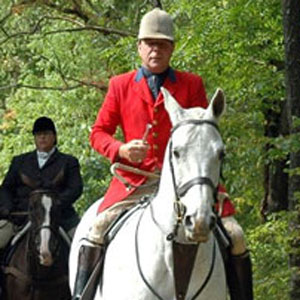 Hugh Robards cubhunting with the Rolling Rock HuntTalk about experience. Hugh Robards has spent fifty-three years in hunt service. He whipped-in to some of the legendary huntsmen in England—Brian Gupwell at the Eridge (later to become huntsman for the Duke of Beaufort), Percy Durno and Captain Ronnie Wallace at the Heythrop, and Charlie Wilkin at the Wynnstay.
Hugh Robards cubhunting with the Rolling Rock HuntTalk about experience. Hugh Robards has spent fifty-three years in hunt service. He whipped-in to some of the legendary huntsmen in England—Brian Gupwell at the Eridge (later to become huntsman for the Duke of Beaufort), Percy Durno and Captain Ronnie Wallace at the Heythrop, and Charlie Wilkin at the Wynnstay.
Upon Captain Wallace’s recommendation to Lord Daresbury, MFH of the County Limerick Foxhounds, Hugh moved to Ireland to take up his first post as huntsman. There he remained for twenty-seven seasons showing world-class sport to the Irish—none keener—and visiting sportsmen and women from around the globe.
After parting from the Limerick, he came to the U.S. to help rebuild the Rolling Rock Hunt (PA), remaining there as Master and huntsman until 2007. From Rolling Rock he moved to the Saxonburg Hunt (PA) where he served as huntsman until coming to the Middleburg Hunt last year as first whipper-in to huntsman Barry Magner. (Barry is moving to Australia this season, and we hope to catch our readers up with him in another article.)
“Hugh continually reinvents himself because of his love for his work,” said Juli Robards, his wife. “Transcending change is one of his great qualities, and I’m unabashedly one of his biggest fans!”
Those who have hunted behind him are big fans as well. Tony Leahy, who grew up in Ireland, is first vice-president of the MFHA and serves as Master and huntsman of the Fox River Valley Hunt (IL). “Hugh is without question one of the best huntsmen I’ve seen,” said Tony. “I remember hunting behind him at Limerick, and I’ve seen him do amazing things!”
Huntsmen on the Move
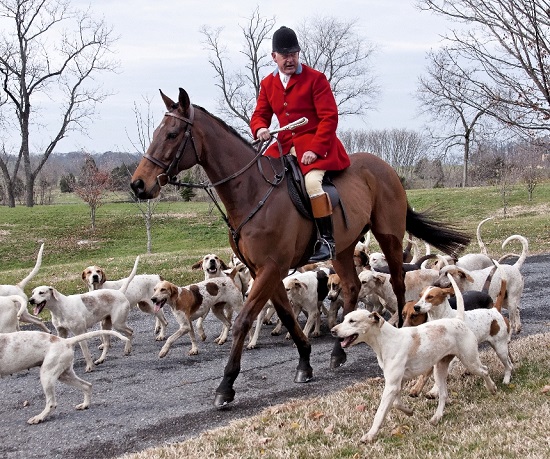 Dennis Downing is the new huntsman at the Bedford Hunt (VA). / Karen L. Myers photo
Dennis Downing is the new huntsman at the Bedford Hunt (VA). / Karen L. Myers photo
Huntsman Robert Taylor hasn’t had a good rest in five years. He’s been hunting two separate packs of foxhounds in Maryland—the Goshen Hounds as Master and amateur huntsman and the New Market-Middletown Valley Hounds as professional huntsman. Huntsman Ken George has been driving hounds and horses six hours each way twice a week from Kansas to Iowa to hunt hounds in both states. Huntsmen love what they do, but each season ends with changes in the wind.
As this hunting season draws to a close, we see huntsmen on the move again. Starting in the north and progressing southward then west, here’s what we know so far; please let us know who we’ve left out.
Hugh Robards Brings World-Class Experience to Middleburg Hunt
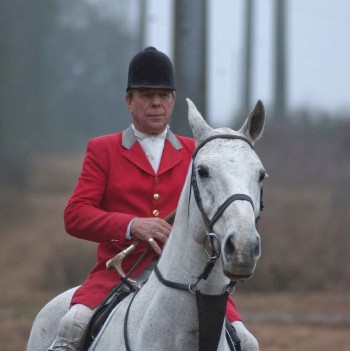 What does a huntsman do when he finds himself in the autumn of his prime? The same question faces every athlete who commits his or her life to a sport. Some carry on doggedly until they are unable to continue or until their career is terminated by outside forces. Others find a path to contribute their experience and knowhow to the benefit of a new team in a different way.
What does a huntsman do when he finds himself in the autumn of his prime? The same question faces every athlete who commits his or her life to a sport. Some carry on doggedly until they are unable to continue or until their career is terminated by outside forces. Others find a path to contribute their experience and knowhow to the benefit of a new team in a different way.
Foxhound in the House
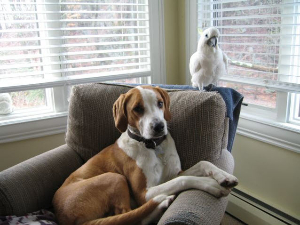 At home with Cathy and friendCathy Eising has a twenty-month-old foxhound out of her mother’s rescue foxhound, and she works at his training diligently. She writes:
At home with Cathy and friendCathy Eising has a twenty-month-old foxhound out of her mother’s rescue foxhound, and she works at his training diligently. She writes:
“I am seeking advice on how to raise the foxhound as a family dog, especially off-leash training. Will he ever stop chasing wild things and pay attention to me outdoors? I have done a lot of obedience with him, and all areas are coming well except off leash outdoors. He needs to run and I can't walk fast enough or long enough for him to get properly exercised, so I need to trust that he will come when called under all circumstances (including around deer). I'm very dedicated and work with him every day.”
Saxonburg Hunt Extends Its Season in South Carolina
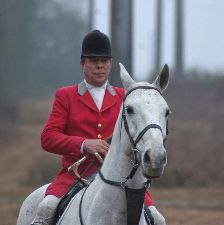 Author Hugh Robards is huntsman of the Saxonburg Hounds (PA). / Alex Farnham photoThe foxhounds of the Saxonburg Hunt in Pennsylvania now have a winter kennel in South Carolina of which full advantage is taken from January 1 to the end of March each year. Since Mr. Floyd Wine, MFH invested in property close to the small town of Salley (population about 450 and home of the annual Chitlin Strut!), the harsh Pennsylvanian winters are no longer an obstacle to continued hunting.
Author Hugh Robards is huntsman of the Saxonburg Hounds (PA). / Alex Farnham photoThe foxhounds of the Saxonburg Hunt in Pennsylvania now have a winter kennel in South Carolina of which full advantage is taken from January 1 to the end of March each year. Since Mr. Floyd Wine, MFH invested in property close to the small town of Salley (population about 450 and home of the annual Chitlin Strut!), the harsh Pennsylvanian winters are no longer an obstacle to continued hunting.
As the country hunted is shared with the Edisto River Hounds it was decided this year to have a Hunt Festival Week. Each pack hunted on alternate days with tailgate parties, dinner parties, and a Hunt Ball thrown in for good measure.
